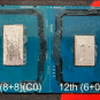MSI revealed that there are two varieties of the desktop Alder Lake versions: a chip with up to 8 P-cores and 8 E-cores (for a total of 24 threads), followed by a lesser brother with up to 6 P-cores and no E cores (12 threads). The larger of the two has a surface area of 215 square millimeters, while the smaller one has a surface area of 163 millimeters.
A comparison of these two chips reveals that the hotspots are located in different areas on each chip, which can result in cooling concerns. Intel announced the release of its twelfth-generation desktop processors earlier this week. The Alder Lake-S SKUs, which have been unveiled, combine powerful Golden Cove cores with energy-efficient Gracemont cores, which should result in lower power usage, according to the company. The ratio of P-cores to E-cores changes depending on the specific model, and chips containing just P-cores will be added later on in the development cycle.
The size perf and zero energy die are not used with the i9-12900K(F), i7-12700K(F), and i5-12600K(F) processors because these processors are equipped with the more cost-effective Gracemont cores. Intel is anticipated to unveil the first processors that make use of the smaller chip early next year, including the i3 and Pentium variants, according to industry sources.
Alder Lake desktop processors use die size differ, has an effect on cooling



